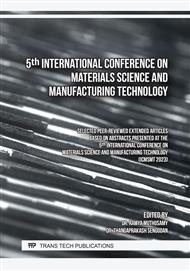[1]
Barakat M. A., Kumar Rajeev, Modified and New Adsorbents for Removal of Heavy Metals from Wastewater, The Royal Society of Chemistry. (2015) 193-211.
Google Scholar
[2]
Bhagat R. M., Khandeshwar S. R., A Synoptic Review on Composite Adsorbents to Remove Heavy Metals from Industrial Wastewater, International Journal of Innovations in Engineering and Science. Vol 4 No.8, (2019) 1-5.
Google Scholar
[3]
Malik D.S., Jain C.K, Yadav A. K., Preparation and characterization of plant based low-cost adsorbents, Vol. 4 Issue 1(2015) 1824-1829.
Google Scholar
[4]
Kaushal A., Singh S. K., Removal of heavy metals by nano-adsorbents: A review, Journal of Environment and Biotechnology Research. Vol. 6 No. 1 (2017) 96-104.
Google Scholar
[5]
Tripathi A, Ranjan R., Heavy Metal Removal from wastewater using Low-Cost Adsorbent, Journal of Bioremediation and Biodegradation. Vol. 6 Issue 6, (2015), 313-315.
DOI: 10.4172/2155-6199.1000315
Google Scholar
[6]
Nabi S. A., Rani B., A. H. S., Faheem A., Development of Composite Adsorbent for Pollutants Removal from Environmental Wastes, Chemical Engineering Journal. Vol .165 issue 2 (2010) 405-412.
DOI: 10.1016/j.cej.2010.08.068
Google Scholar
[7]
Karnib M, Kabbani A., Holail H., Olama Z, Heavy Metals Removal Using Activated Carbon, Silica and Silica Activated Carbon Composite, Energy Procedia. Vol. 50 (2014) 113-120.
DOI: 10.1016/j.egypro.2014.06.014
Google Scholar
[8]
Bushra R, Shadat M., Raeissi A.S. Nabi S.A., Development of Nano-composite Adsorbent for Removal of Heavy Metals from Industrial Effluent and Synthetic Mixture: its Conducting Behavior, Desalination. Vol. 289 (2012) 1-11.
DOI: 10.1016/j.desal.2011.12.013
Google Scholar
[9]
Nabi S. A., Shahadat M., Bushra R., A. H. Shalla, Heavy Metals Separation from Industrial Effluent, Natural Water as well as from Synthetic Mixture using Synthesized Nivel Composite Adsorbent, Chemical Engineering Journal. Vol. 175 (2011) 8-16.
DOI: 10.1016/j.cej.2011.01.022
Google Scholar
[10]
Fenglian F., WangQ., Removal of Heavy Metal Ions from Wastewater: a Review, Journal of Environmental Management. Vol. 92 (2011) 407-418.
Google Scholar
[11]
AeisyahA.S., Halim Shah Ismail H.S., Kamal L., Izhar S., Adsorption Process of Heavy Metals by Low-cost Adsorbent: A Review, World Applied Sciences Journal. 28 (11) (2013) 1518-1530.
Google Scholar
[12]
Barkat M. A., New Trends in Removing Heavy Metals from Industrial Wastewater, Arabian Journal of Chemistry. 4, (2011) 361-377.
DOI: 10.1016/j.arabjc.2010.07.019
Google Scholar
[13]
Abdel S.O. Reiad N.A., ElShafei M.M., A study of the Removal Characteristics of Heavy Metals from Wastewater by Low-cost Adsorbent, Journal of Advaced Research. Vol. 2 (2011), 297-303.
DOI: 10.1016/j.jare.2011.01.008
Google Scholar
[14]
Crini G., Lichtfouse E., Wilson L.,Morin-Crini N. "Conventional and non-conventional adsorbents for wastewater treatment" Environmental Chemistry Letters. volume 17, (2019).195–213.
DOI: 10.1007/s10311-018-0786-8
Google Scholar
[15]
Gisi S.D, Lofrano G., Grassi M., Notarnicola M. "Characteristics and adsorption capacities of low-cost sorbents for wastewater treatment: A review" Vol. 9 (2016), 10-40.
DOI: 10.1016/j.susmat.2016.06.002
Google Scholar
[16]
Sihem A., Lehocine M B. , MINIAI H.A "Preparation and characterization of an natural adsorbent used for elimination of pollutants" Energy Procedia. Vol. 18, (2012) 1145-1151.
DOI: 10.1016/j.egypro.2012.05.129
Google Scholar
[17]
Bushra R. "Development of nano-composite adsorbent for removal of heavy metals from industrial effluent and synthetic mixtures" Desalination. Vol.289, (2012) 1-11.
DOI: 10.1016/j.desal.2011.12.013
Google Scholar
[18]
Nhapi I., Banadda N., Murenzi R. , Sekomo C.B. , Wali U.G "Removal of Heavy Metals from Industrial Wastewater Using Rice Husks" The Open Environmental Engineering Journal. Vol. 4(1) (2011).
DOI: 10.2174/1874829501104010170
Google Scholar
[19]
M. Visa, Tailoring fly ash activated with bentonite as adsorbent for complex wastewater treatment, Appl. Surf. Sci. 263 (2012) 753–762.
DOI: 10.1016/j.apsusc.2012.09.156
Google Scholar
[20]
V.O. Njoku M.A. Islam,M. Asif, B.H. Hameed, Utilization of sky fruit husk agricultural waste to produce high quality activated carbon for the herbicide bentazon adsorption, Chem. Eng. J. 251 (2014) 183–191.
DOI: 10.1016/j.cej.2014.04.015
Google Scholar
[21]
H.I. Owamah, Biosorptive removal of Pb(II) and Cu(II) from wastewater using activated carbon from cassava peels, J. Mater. Cycles Waste Manage. 16 (2014) 347–358.
DOI: 10.1007/s10163-013-0192-z
Google Scholar
[22]
Kulkarni S.J., Dhokpande S.R., Kaware J. P. "Studies On Flyash As An Adsorbent For Removal Of Various Pollutants From Wastewater" Vol. 2 Issue 5, (2013) 1190–1195.
Google Scholar
[23]
Pandharipande S.L., Dhomane S., Suryawanshi P., Dorlikar N. "Comparative studies of adsorbents prepared from agricultural wastes like bagasse, jackfruit peel & ipomoea fistulosa" Vol. 1 Issue 3 (2012) 214-216.
Google Scholar
[24]
J. Anwar, U. Shafique, Z.Waheed uz, M. Salman, A. Dar, S. Anwar, Removal of Pb(II) and Cd(II) from water by adsorption on peels of banana, Bioresour. Technol. 101 (2010) 1752–1755.
DOI: 10.1016/j.biortech.2009.10.021
Google Scholar
[25]
M. Xu, P. Yin, X. Liu, Q. Tang, R. Qu, Q. Xu, Utilization of rice husks modified by organomultiphosphonic acids as low-cost biosorbents for enhanced adsorption of heavy metal ions, Bioresour. Technol. 149 (2015) 420–424.
DOI: 10.1016/j.biortech.2013.09.075
Google Scholar



